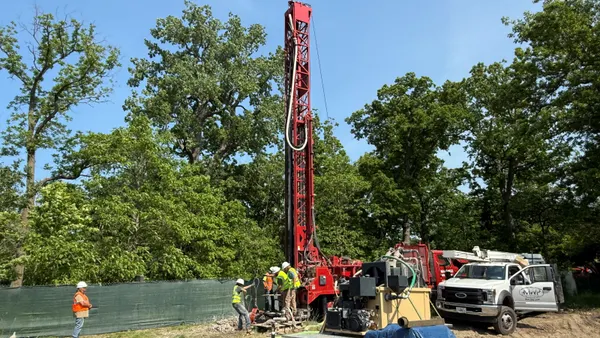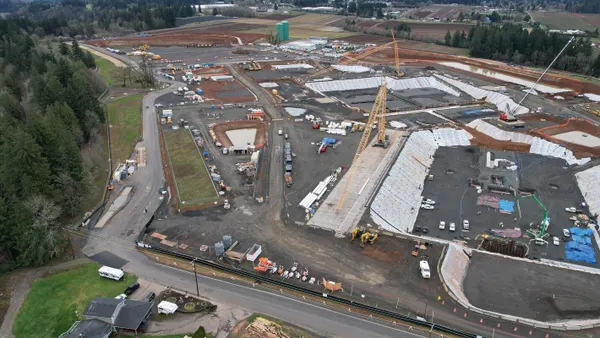Green building product innovations have been at the forefront of the Greenbuild conference this week. During the show, Alex Wilson and Brent Ehrlich, of publishing company BuildingGreen, presented what the company — after reviewing hundreds of different options from manufacturers — predicts will be the top green products on the market next year. From urinals to office chairs, BuildingGreen's list offers a look at what's ahead in the rapidly evolving sector.
1. Personal Comfort Systems Hyperchair
Researchers with the Center for the Built Environment at the University of California, Berkeley have been developing the Personal Comfort Systems Hyperchair, which aims to improve the comfort levels of people in office settings. Currently, buildings use large amounts of energy to accommodate the different temperature preferences of office workers, Wilson said.
This Hyperchair gives people the ability to control their individual temperature setting with a smartphone. The chair uses a lithium ion phosphate battery that charges at night and during off-peak hours. Currently, the new technology is being tested out in the new office building for the Rocky Mountain Institute in Colorado. "The idea that people can be conditioned is revolutionary," Wilson said.
2. Gunlocke Savor Guest Chair with Ecovative Myco Board Backing
Furniture manufacturers are currently trapped in the practice of using synthetic formaldehyde adhesive components, according to Ehrlich. But Gunlocke, a furniture manufacturer, decided to break from the pack and utilize Myco Board technology from Ecovative — which recently won the Saint-Gobain 2015 NOVA Innovation Competition — as an alternative building material. Myco Board is formaldehyde-free and is made up of biomaterials that don't harm the environment.
The eco-friendly material also offers a cost-competitive option. Gunlocke chose the product not just for its environmentally safe qualities, but for its superior quality and cost-effectiveness, according to Ehrlich. "Kudos to Gunlocke for taking a leap of faith" with this new product, he said.
3. Sloan Hybrid Urinal
Waterless urinals have emerged as an option to significantly reduce water usage. However, they also are more susceptible to build-up and poor maintenance, according to Wilson. The Sloan product offers a new type of urinal that uses "Jetrinse Solution Technology" to send one gallon of water through the system every 72 hours. That feature eliminates the need for constant maintenance that other waterless urinals require, and uses only about 120 gallons of water per year.
The Hybrid Urinal is powered by a Li-ion battery and has an eight-year lifespan. Although it sends water through the urinal every 72 hours, the product reduces the amount of water and time required for maintenance. "It could potentially save more water than waterless urinals," Wilson said. "We expect hybrid will change the game."
4. Unity Homes High-Performance Panelized Homes
Residential construction is stuck in its habits of using only on-site, stick-built construction methods with minimal insulation and unsustainable materials. But Unity Homes, based in New Hampshire, is looking to defy those traditional practices and implement off-site construction along with more sustainable materials used for the home. The company, along with sponsors, built a home to display on the Greenbuild show floor.
The 1,620-square-foot house — designed using computer-assisted manufacturing, or CAD/CAM technology — was constructed as multiple panels and pods off-site and then shipped to the conference and assembled on-site. The house, which has the potential to be net-zero with the use of solar panels, also used environmentally friendly products and a panelized wall system with tight seals and improved insulation. The company said it also has the ability to adapt this system to construct multifamily buildings or tiny houses.
5. Whirlpool HybridCare Ventless Heat Pump Dryer
Drying technology has seen very little advancement in the last 40 years, Wilson noted. Whirlpool has developed a new clothes-drying system that uses an energy-efficient heat pump and a refrigeration system to dry and recycle the same air. The product can result in 40% in energy savings for a home, comes with a reduced fire risk, and is easier on the clothes during the drying process.
The HybridCare Ventless Heat Pump Dryer is available in Europe, and is coming to the U.S., according to Wilson.
6. Honeywell Solstice SPL Liquid Blowing Agent
Foam insulation with blowing agents that contribute to global warming are basically a standard in the construction industry. However, multinational corporation Honeywell has created a new liquid blowing agent that essentially erases its potential to contribute to global warming, according to Wilson. The product aims to increase foam yield, improve compressive strength, and deliver a higher R-value.
Commercial production for the Honeywell Solstice Liquid Blowing Agent began this year, but 2016 will see expanded growth for the product. It is currently used by Whirlpool and West Development Group for certain projects, Wilson said.
7. Tesla Powerwall and Powerpack
Similar to the way it has revolutionized the automotive industry, Tesla is about to make major waves in solar storage, according to Wilson. Currently, there is not an effective way for homeowners with solar panels to store the energy produced overnight, or to completely cut off from the grid. But the Powerwall — and larger-scale Powerpack for utilities — offers battery storage and back-up with a rechargeable lithium-ion battery.
The PowerWall, currently in production, will come in two sizes — the10 kWh battery for backup applications and the 7 kWh battery for daily cycling applications. The 10 kWh battery's announced price for installers is $3,500, and the price for the 7 kWh battery is $3,000. "The price is revolutionary," Wilson said. "I think we'll see a real uptake in this technology."
8. Duo-Gard Bike Racks and Shelters
Transportation is the "low-hanging fruit of energy savings," Ehrlich said. Oftentimes, the amount of energy consumed getting to an office is equal to, or even more, than the amount of energy the building takes up, he noted. Increasing the number of people who bike can dramatically impact energy consumed by transportation. Duo-Gard is developing new and innovative ways to store and provide shelter for bikes, especially in urban areas.
Duo-Gard offers several different biking products, including standard racks, as well as fully enclosed shelters and bike depots. An influx of these types of bike storage options could encourage more people to elect to bike rather than drive, according to Ehrlich. "A tip of the hat to Duo-Gard for getting bike storage into the mainstream," he said. "I have a feeling you'll see a real explosion in products like these."
9. Sanden Heat Pump Water Heater with CO2 refrigerant
Most heat pumps used today include refrigerants that can contribute to global warming, according to Wilson. The Sanden CO2 Heat Pump Water Heater, however, uses CO2 as a refrigerant, which drastically reduces its global warming potential. The company touts its benefits as featuring high efficiency, reliability and safety, as well as allowing for low-temperature installation.
This type of technology has already been available in Japan for years, but it will start to arrive in the U.S. in full force next year, according to Wilson.
10. NuLED Power-over-Ethernet low-voltage LED lighting
Currently, high-voltage wiring — which is extremely expensive to install and modify — is used with LED lighting, according to Ehrlich. NuLED's Power over Ethernet low-voltage LED lighting technology connects lighting to the Internet and uses low-voltage cables. The LED light fixtures can become fully programmable through the Internet with NuLED's technology.
The process is much safer and easier to wire, and can be installed by a non-electrician."I got a feeling that in 10 years, this is going to be the industry standard," Ehrlich said.












